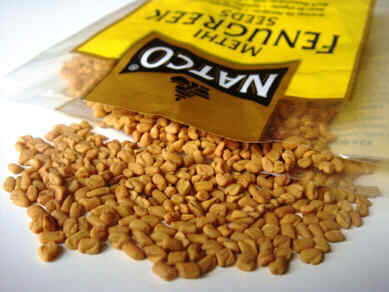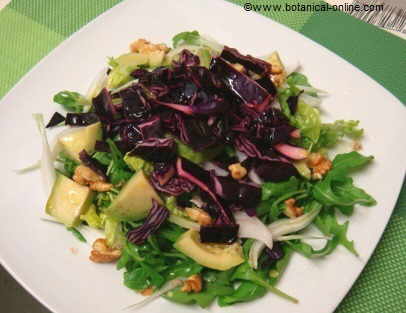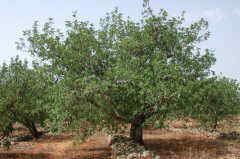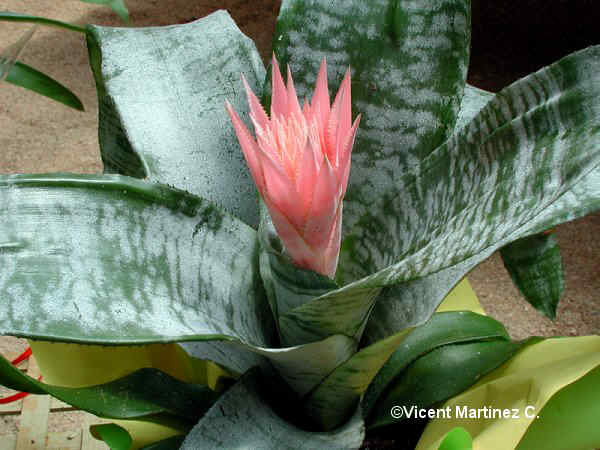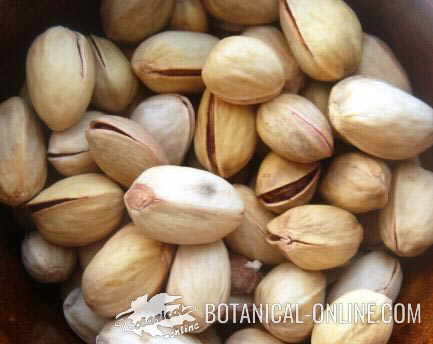Contents
What is a buckwheat?
Characteristics of buckwheat
Common English name: buckwheat, beech wheat.
Common name in other languages:
– Spanish: alforfón, alforjón, trigo sarraceno, trigo negro, trigo-haya, trigo turco, morisco, moro o árabe.
– Catalan: fajol, negre blat, blat Sarrai, Cairat, blat cairut.
– French: sarrasin, blé noir, renouée, bouquette
– Italian: fagopiro, grain saraceno, sarasin, faggina.
– German: Buchweizen, Heidekorn
Scientific name: Fagopyrum esculentum Moench.
Synonym: Polygonum fagopyrum L.
Family: Polygonaceae
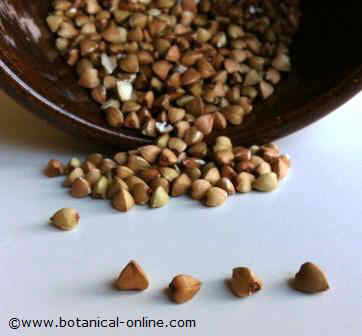
A detail of buckwheat grains
Habitat: plant native to the Chinese region of Manchuria. In ancient times it was widely cultivated throughout China and later it was introduced in Russia and Europe by the Tartars and Turkish incursions in the late Middle Ages.
Buckwheat arrived in England in the seventeenth century, although it was the Dutch who exported this plant to the U.S. in the same century.
This plant grows wild in parts of North Eastern Europe, such as Poland and Russia, where for many centuries formed part of the diet of these populations who used it for flour or cooked with vegetables and cereals.
It grows in acid soils, neutral and basic or alkaline, and tolerate very acidic soils. It can grow in dry and wet places. It is NOT frost resistant but it can resist drought itself. Cultivation requirements are minimal.
Description of buckwheat
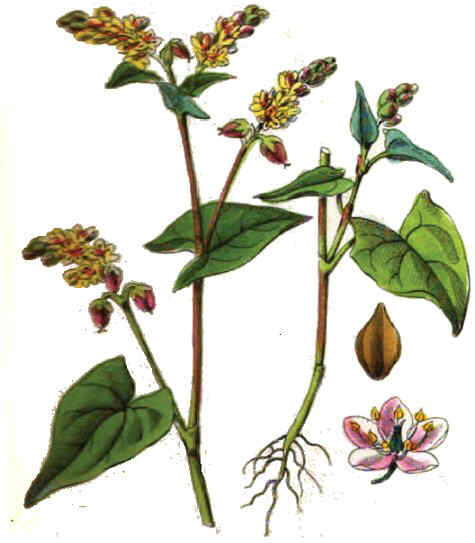
A drawing of the plant
First it should be emphasized that buckwheat, unlike what you can guess from its name, is not a cereal. A grain is a plant belonging to the botanical family of grasses (rice, rye, barley, wheat). Instead, buckwheat belongs to the Polygonaceae family. It is, for example, a relative of rhubarb (Rheum rhabarbarum) and Sorrel (Rumex acetosa).
However, buckwheat is considered a pseudocereal because of its high starch content and its use in food such as flour and grain. Other pseudocereals are quinoa and amaranth.
Buckwheat is a robust herbaceous plant, with annual growth that can measure 20 to 70 cm (1 meter high in some areas).
Its roots form a taproot from which small secondary roots grow.
The stem is erect, gnarled and green, but can sometimes present red colors. The nodal ochreas buckwheat possess are characteristics in Polygonaceae. (An ochrea or ocrea is a sort of structure formed by fused stipules that surrounded the stems)
Plant leaves grow alternately and are characteristically large and sagittate (heart-shaped). The upper leaves are perfoliate (born in the stem and around him, clasping); lower ones, however, have a petiole that joins the stem.
Each stem terminates in an inflorescence in small clusters or clusters of flowers.
Buckwheat flowers are monoecious. They are pollinated by bees. In fact, buckwheat is characterized by attracting wildlife during flowering, which occurs from July to September in the northern hemisphere.
These flowers are white or pink. They are pentameric flowers, that’s to say, each one consisting of a corolla and calyx formed by five petals and five sepals respectively. It is a honey plant.
The fruit of this plant is a dry fruit achene with three edges that is used for human consumption. Buckwheat is characterized by trigonal shape, which makes it unique. This grain is covered by a blackish brown cuticle that is not edible, and that forces the grain to be peeled to be eaten or for marketing. These grains resemble the beech tree seeds, for its triangular shape, although those from beech tree are larger. Buckwheat, therefore, is also called ” trigo-haya”= beech-wheat” in some Spanish speaking regions.
Nutritional composition of buckwheat
- Carbohydrates: buckwheat grain contains mainly carbohydrates, in the form of starch, in a proportion of 70%. This is more than other cereals like maize, so buckwheat flour is typically used as a thickener or for making resistant pasta as traditional Japanese soba noodles
Buckwheat contains a type of sugar called fagomine, a molecule responsible for regulating hunger and appetite.
- Protein: after the starch, the major component of buckwheat is protein. In contains lysine, a deficient amino acid in all cereals, and methionine, limiting amino acid in legumes. For these reasons it combines perfectly with cereals and legumes, because buckwheat increases the biological value of their proteins. Furthermore, IT HAS NO GLUTEN, making it ideal for coeliacs.
- Fat: buckwheat contains almost no fat, 3.40 g per 100g of product. Like other cereals and plant foods containing fat, these are mono and polyunsaturated fats, which makes it a very healthy food for people with vascular problems and cholesterol.
- Fiber: fiber content of buckwheat is significant, because it has a content comparable to whole grains (without being a cereal). It is predominantly soluble fiber, reason why it acquires a slightly gelatinous texture when boiling it
- Vitamins: We should highlight the presence of niacin, folic acid, pantothenic acid, and, to a lesser extent, other vitamins in foods rich in carbohydrates, thiamin and riboflavin.
- Minerals: it contains zinc, magnesium and potassium, with low sodium content, which gives it diuretic properties. It also contains selenium, a powerful antioxidant abundant also in the dairy products.
- Flavonols: flavonols with phenolic compounds or flavonoids. Among flavonols, routine stands out, which is employed by the pharmaceutical industry as a drug for the treatment of vascular disorders. It is found in the leaves, stems, flowers and grains of this plant. It also contains quercetin and hesperidin, flavonoids with antioxidant effect.
- Anthocyanins: anthocyanin that buckwheat contains are cyanidin, and two glycosides of cyanidin.
- The C-glycosylflavones (or glycosides) found in the grain of buckwheat are vitexin, iso-vitexin, orientin and iso-orientin.
- Benzoic acids: hydroxybenzoic, vanillic and coumaric acid.
- Other flavonoids: lignans, enterolactone..
* See details of composition
Varieties of buckwheat
- Common buckwheat (Fagopyrum esculentum) is the species most cultivated buckwheat world. A variety of this (Fagopyrum esculentum) is Tokyo buckwheat, honey plant very appreciated by beekeepers and consumers.
- Perennial wild buckwheat (Fagopyrum cymosum). It seems to be the oldest species of buckwheat, its characteristics are similar to common buckwheat. It is only used as a vegetable. It is found naturally in Asia: parts of China, Japan and the Himalayas.
- Tartary buckwheat (Fagopyrum tataricum / Fagopyrum kashmirianum). Fastgrowing plant, which can reach up to 1 meter high. It is grown in Pakistan, Himalaya, China, Canada and mountainous areas of the United States. It is characterized by the greenish color of its seeds and its bitter taste, so it is used for animal feed or for mixing with wheat flour. It is also used for medicinal purposes.
![]() More information about buckwheat
More information about buckwheat

